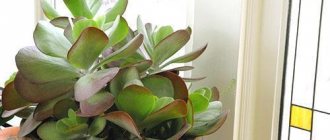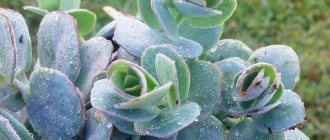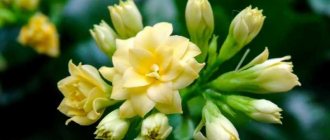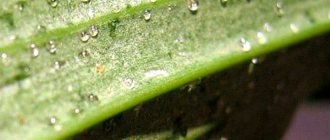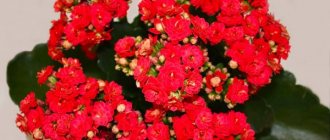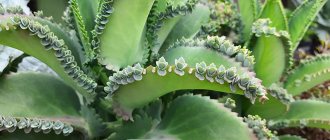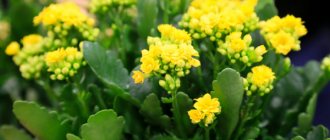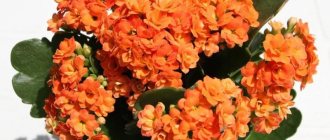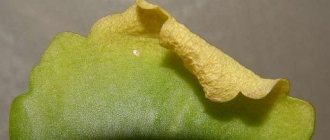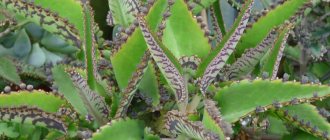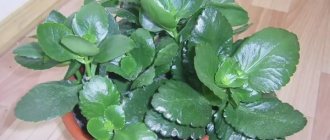Description of the genus Kalanchoe
Kalanchoe, part of the family Crassulaceae (Crassulaceae), is a fairly large genus, which includes 1 species from the Americas, 56 species from southern and eastern Africa, 60 species from Madagascar and several species from Asia. In total, the genus Kalanchoe has about 125 species. The island of Madagascar has the largest number of species of this genus, suggesting that it is the ancient center of speciation and possibly the place of origin of Kalanchoe. After all, Madagascar is the only region where epiphytic, woody, liana-like and herbaceous varieties of Kalanchoe live.
Photo of Kalanchoe rhombopylosa
Previously, the genus Kalanchoe included not only its natural varieties, but also representatives from other genera. Because of this, even now there is often confusion with the total number of species of the genus. This confusing situation is due to the fact that taxonomic classification has not yet been carried out for Kalanchoe.
At the time of discovery, many plants were given very different names: in the 18th century they were known as Cotyledon, from 1805 they were included in the genus Bryophyllum (Bryophyllum), and only 80 years later they were reclassified as the genus Kalanchoe. The current quantitative composition of the genus was determined only in the middle of the 20th century. And the closely related Bryophyllum was separated into a separate genus and is currently considered as one of three sections of the genus Kalanchoe.
Description of the appearance of Kalanchoe
Most members of the genus tend to be perennial succulent crops in their natural habitat. Some species are annual or biennial plants. Outwardly, they may look like ordinary succulents, some like shrubs or even trees. Several species are classified as epiphytes, that is, they grow on the surface of other plants; there are also climbing plants. Naked or hairy succulent plants can reach heights ranging from a few centimeters to 3-4 meters.
Photo of Kalanchoe laxiflora
The fleshy, sometimes woody stems of succulents often have multiple branches, depending on the species. The fleshy leaves are varied in shape, usually arranged oppositely, sometimes in whorls of three, rarely alternate. The leaves are entire or serrated, lobed, pinnately incised or pinnately divided. In some species, plant buds are located right at the edges of the leaves, from which new plants develop.
Photos of flowers of different types of Kalanchoe
Monoecious flowers open on erect stems. Each of them consists of four, more or less fused sepals and petals, which grow together into a tube and have bright colors. The tips of the petals are curved back.
Kalanchoes are short-day plants and they bloom when the day length is equal to or less than 12 hours. If pollination occurs, after flowering four erect follicle fruits containing many small seeds are formed.
Probably the most famous species of this genus is Kalanhoe blossfeldiana and its cultivars, thanks to its flowers. But some Kalanchoe species are prized for their colorful foliage rather than their flowers. For example, Kalanchoe tirsiflora is prized for its large leaves and rough texture.
We would like to remind you that most species of Kalanchoe have poisonous sap and are toxic. They should be kept away from pets and children.
Types of medicinal Kalanchoe with photos and names
This group of succulents is very famous for its medicinal properties and although it is represented by only a few species.
Kalanchoe Degremont or Daigremont (Kalanchoe daigremontiana)
This is an unpretentious single-stem plant covered from top to bottom with large blue-green leaves. Its narrow, pointed leaves can grow up to 15 cm in length and about half as wide. The real attraction of this succulent is the tiny sprouts that grow along the edges of the leaves, which fall off easily and take root where they fall.
Because of this feature, K. Degremon is called the “viviparous Kalanchoe.” Flowers become an additional decoration of this ornamental plant. You can learn more about this succulent and its medicinal properties from our article.
Kalanchoe pinnata
Another medicinal plant, which is a shrub reaching a height of up to 2 meters. The branches are spreading, the leaves are arranged oppositely, with the lower leaves being slightly larger than the upper ones. The flowers of Kalanchoe pinnate are bell-shaped, consist of 4 petals, collected in the form of spreading panicles, purple or red.
Kalanchoe pinnate is widely used for medicinal purposes, including the treatment of respiratory diseases (asthma, cough, tuberculosis) and pain (headaches, painful urination/kidney infections). In some countries, its leaves and juice are used as a cooling tea or as a poultice for ulcers.
Kalanchoe dissected or lobed (Kalanchoe laciniata)
In everyday life, this succulent is called “Deer Horns”. A very beautiful, but rarely seen species. Grows up to one meter in height. Stems are fleshy, glabrous or slightly pubescent, slightly branched. The main feature of this plant is its oddly shaped green leaves.
When the plant blooms, you may see greenish-white or light orange tubular flowers appear. Kalanchoe laciniata is rich in medicinal properties, namely:
- antidysenteric drug - a carrier medicine and prevention of dysentery;
- hemostatic medicine;
- anti-inflammatory;
- an excellent antiseptic - able to prevent infection by suppressing the growth of infections.
- prevents and treats ulcers;
- diuretic and other properties.
General rules for caring for indoor Kalanchoe flowers
Each species of this genus has its own requirements for light, soil, watering and other criteria. In our articles about these species, we described in more detail the conditions for growing these varieties at home. Here we will describe the general requirements and describe the flowering features in more detail.
What soil composition is optimal for Kalanchoe
Since Kalanchoe is a succulent, the potting medium should be fast-draining. The pH value should be between 6.0 and 6.5. Almost all Kalanchoes are sensitive to zinc deficiency and high phosphorus. Most members of the genus also have high calcium requirements.
- Desert varieties of Kalanchoe require a substrate poor in organic matter, consisting of equal parts of loam and sand, with the addition of pumice or stone chips to ensure good drainage.
- Some species, such as Kalanchoe Blossfeld and its varieties, prefer the presence of a small amount of organic matter in the soil.
Lighting requirements
Mature plants grow best in full sun or partial shade. At home, Kalanchoe should be grown in a well-lit window. But there are nuances. For example, flower formation in Kalanchoe Blossfeld is stimulated by a very short photoperiod. When growing this type of succulent in a pot, it can be stimulated to produce more buds and flowers by giving it 8 to 10 hours of sunlight per day.
Succulent Information
Crassula ovoid or “Money tree”
The most common succulent is Sedum or Sedum.
Succulent Adromiscus: features of the genus
Temperature
All Kalanchoes grow well at normal room temperature. Most of them are native to Africa and can easily tolerate heat. Plants bloom at temperatures from 15 to 16 °C. Avoid temperatures below 5°C as the plant may die within a few hours.
Watering
In autumn and spring, moderate watering is sufficient, but in hot summers, water more frequently and generously and allow to dry out before watering again. In winter, it is worth moistening the soil occasionally (when the plant begins to wither). If during this period you do not reduce the frequency of watering, then the Kalanchoe will grow as usual and will not have a dormant period.
Overwatering is the most common cause of death of succulents. Also avoid using cold water when watering plants, as this can lead to various diseases.
Fertilizer application
Fertilizing requires some attention. You can add liquid fertilizer for flowering succulents diluted in water at half the strength every two to three weeks. Most other Kalanchoe species should be fertilized no more than once a month. They do not require any fertilizer in winter.
Replanting Kalanchoe
Unlike ordinary houseplants that prefer to live in a pot, Kalanchoe grows best if replanted fairly often. For best results, replant desert Kalanchoes annually in the spring and flower varieties in the fall after the plant has finished blooming—this will encourage new growth and increase future blooms. Increase the container by one size each time you replant.
Kalanchoe beharensis
Be sure to use a pot with good drainage. A container made of clay or ceramic is the best choice, as these materials are porous and will help keep the soil relatively dry.
Popular Kalanchoe species with amazing leaves
In this group we have collected succulents, which are primarily valued for the wonderful color of their leaves. Few natural plant species of other genera can boast of their spectacular spotted or multi-colored leaves.
Kalanchoe humilis
A spectacular low-growing perennial succulent with very decorative leaves with pronounced burgundy stripes. Forms a small shrub 30-90 cm high. The stem is relatively short - up to 10 cm long, growing from a woody base up to 1 cm thick, unbranched or with several branches, purple or slightly gray.
Leaves are up to 13 cm and 6 cm wide, completely glabrous, gray-green with a slight grayish-brown coating on both sides. Pronounced burgundy spots and stripes on the leaves are a distinctive feature of this species. As the plant ages, the leaves at the bottom of the plant fall off. An erect, branched panicle up to 12-38 cm grows from the center of the rosette and produces abundant flowers from green to pink.
Another popular cultivar of this species is Kalanchoe humilis cv. Desert Surprise: A bred clone with blue-green lobe-shaped leaves with striking purple spots.
Marbled Kalanchoe (Kalanchoe marmorata)
Another species with beautiful leaves. Endemic to Central and Western Africa. The succulent forms a small bush 30-40 cm high and wide at home, although it reaches 1.2 m in the wild.
The name of the species was given because of its brightly colored leaves with brownish-purple spots. The erect inflorescences grow up to 10 cm in length and contain delicate, star-white, four-petaled flowers, sometimes tinged with pink.
Kalanchoe mysterious (Kalanchoe orgyalis)
The species is native to the island of Madagascar. A slow growing plant, it forms a rather stately plant when mature, known for its hairy bronze leaves.
Over time, the lower leaves turn silver, creating a beautiful contrast with the newer copper leaves. Because of the shape and color of the leaves, Kalanchoe mysticus is often called copper spoons.
Kalanchoe rhombopilosa or rhombopilosa
This is an elegant small shrub, one of the smallest species of the genus (no more than 20 cm high), with branched silvery stems with brown spots. The leaves are diamond-shaped or fan-shaped with striking copper-brown markings, most covered with a silvery-white coating.
The outer edge of the leaves is beige with sharp teeth. There are several forms with absent or abundant markings. The flowers are inconspicuous, greenish-yellow with red lines.
Kalanchoe figuereidoi
Another name is “Partridge”. Often confused with Kalanchoe humilis. Compact succulent with wide, silver-gray, fleshy, toothed leaves. On their surface there are dark striped spots and pale veins.
Typically blooming in mid-winter, the inflorescence is forked multiple times to hold a cluster of small pale green and pink flowers with scarlet tips. One of the top ten favorites among experienced gardeners.
How to make Kalanchoe bloom
Probably one of the most common questions asked by beginning gardeners. There are two types of photoperiodic flowering responses that have been observed in most Kalanchoe species: plants that flower after exposure to short days (called short-day plants), and plants that flower after exposure to a specific sequence of long days followed by short days (long- and short-day plants). day). Kalanchoes are short-day plants, and by manipulating the length of day and night, gardeners can achieve flowering plants at any time of the year.
Photo of Kalanchoe scapigera
Research has shown that several species of the genus, including the popular K. blossfeldiana, flower in response to day length, classifying these plants as photoperiodic with respect to flowering.
Long daylight hours stimulate good rooting and vegetative growth. Short days are needed to stimulate flowering.
Common problems in caring for Kalanchoe
Like all plants, these flowers also have natural enemies and diseases. Let's briefly describe them
Diseases
Bacterial stem rot, Fusarium, Pythium root rot, Phytophthora and powdery mildew can cause problems for inexperienced Kalanchoe growers. Try to regularly inspect your flowers for wilting or stunted growth. Often replanting into a new soil mixture or using fungicides will not help if the plant is neglected.
Pests
Kalanchoe's insect problems are similar to other flowering succulents grown at home. Aphids, thrips, mites and mealybugs can be potential problems for unkempt plants. It is worth considering that many succulents are sensitive to many insecticides. We described how to get rid of pests in our article.
Limp leaves and small flowers
If your succulent has been damaged by frost or low temperatures, it will often have damaged leaves or poor flowering.
To avoid this problem, try to keep your plants at temperatures above 15 °C.
Wilting due to heat
In the summer, when the outside temperature rises above 27 °C, you may find wilted leaves on your flower. Try not to overheat the succulent pot during dry periods.
Burn of leaves and stems
If your flower receives too much direct sunlight, most often its leaves and shoots will get sunburn. The best way to protect your home Kalanchoe in the summer is to find a place for it in a room where there is enough bright indirect light or to deliberately shade the pot at lunchtime, when exposure to the sun is maximum.
Soft plant tissue
As a result of frequent watering or the presence of Kalanchoe in an earth mixture that retains moisture for a long time, it can easily cause rotting, first of the roots, then of the stems and leaves. If you notice disturbances in the growth of your succulent, refrain from watering until the plant recovers. You may have to change the soil mixture.
How to propagate succulents of the genus Kalanchoe
Most species can be propagated by seeds, plant division, stem cuttings and sprouts.
- The seed method is quite complex and takes the most time, so it is rarely used.
- Flower division can be done if you find a way to divide the plant into 2 or 3 divisions. In some varieties, the mother plant has several children or a dense bush in one pot, so it is not difficult to separate them.
- If you want to take Kalanchoe cuttings, cut off the top of the stem, about 10-15 cm long, with a few lower leaves removed, and then set it aside for a few days to dry out the cut area. Next, plant the cuttings in a succulent or cactus mix. Rooting will occur in approximately 3 weeks. Try not to spray the foliage while the cuttings are rooting, just the soil.
- The last, easiest method of propagation is by sprouts that grow on the tips of the leaves (but not in all species).
Often they come off the leaf themselves, fall into the pot and germinate. The gardener can simply transplant the sprouted flower into a new pot.
Avoid propagating the plant while it is in flower.
Useful properties of Kalanchoe
The genus Kalanchoe has more than 100 species. Extracts of many varieties are used for medicinal purposes.
- Recent studies have proven that Kalanchoe extracts have various beneficial properties - antiviral, soothing, anti-ulcer properties.
- The composition of extracts of various Kalanchoe species includes polysaccharides, flavonoids,
- The composition of the juice and pulp of the succulent includes sterols, ascorbic acid, various beneficial microelements, organic acids, hydrocarbons, phenolic components and bufadenolides.
- Kalanchoe juice is used for local treatment of periodontal disease, cheilitis, chapped lips in children, treatment of bruises, wounds, boils. For example, in India, insect bites and ear infections are treated with succulent extract; in Nigeria, dysentery, fever, abscesses, coughs, skin diseases, and urinary tract diseases are treated.
- Crushed leaves are rubbed or tied to the head to relieve headaches or rheumatism.
- Kalanchoe extract is a fairly effective immunomodulatory, anti-inflammatory, thyroid, antioxidant, analgesic, anticonvulsant, antimicrobial, cardiovascular, and antihyperglycemic agent.
However, do not use Kalanchoe extract unnecessarily and without the slightest knowledge in the treatment of ailments; it is better to consult a doctor.
This article uses materials from the sites: mygarden.com, growertalks.com, greenhousegrower.com.
Review of other popular Kalanchoe species
Let us briefly describe the features of other, no less interesting varieties of succulents, which are of considerable interest among gardeners.
Kalanchoe delagoensis
This species is a fast-growing plant that easily propagates wherever it goes, thanks to the tiny shoots that grow along the edges of the leaves. Because of this, in Western countries it is called the "Mother of Millions" and is often confused with a similar plant, Kalanchoe Degremona or "Mother of Thousands", which has wider and longer leaves.
Kalanchoe tubiflora produces showy, bell-shaped flowers in coral pink or orange. Keep in mind that these succulents will not always form flower buds, and some may not bloom at all. This largely depends on environmental factors beyond our control.
Kalanchoe farinacea
A rather attractive, low-growing, thick-skinned perennial plant with curious spoon-shaped foliage. Native to the Yemeni island of Socotra. The height of the succulent is up to 30 cm.
This species is easily identified by its white or whitish-green stem and leaves. During flowering, the succulent produces a peduncle from a panicle, on which straight, reddish-orange cross-shaped flowers are formed. Kalanchoe mealy is the only plant of this genus whose flowers are open for the longest period of the day.
Kalanchoe manginii
Also known as Bryophyllum manginii. In everyday life, this succulent is called “Chandelier”. A slow-growing plant whose stems can reach up to 40 cm in length.
Young bushes have erect stems with small shiny green leaves. The leaves are round and turn reddish in bright sunlight. The flowers are red-orange to bright red and bloom in spring. This is a heat-loving plant, the minimum temperature for which should be 10 °C.
Kalanchoe Luciae
Other names: Kalanchoe Lucy. This species is a fast-growing succulent that produces round, disc-shaped leaves covered with a gray coating. The edges of the leaf blades take on a reddish tint during the cooler winter months.
The amount of sunlight affects how much red blush the leaves show. The inflorescence is thin, cylindrical in shape, the flowers are yellowish-green. Kalanchoe Lucia is a very spectacular plant, easy to care for and is a desirable succulent in any collection.
Also worth mentioning is the variegated form of this flower - Kalanchoe luciae 'Fantastic' . This is a variegated variety, characterized by a whole collage of bright foliage colors.
The leaves are grey-green with creamy yellow or white spots comprising 30-80% of the leaf blade, and the leaf margin takes on a reddish hue in full sun during the hot summer and cooler winter months.
Kalanchoe thyrsiflora
The name Kalanchoe quatrefoil is often used to refer to both Kalanchoe thyrsiflora and the more common species Kalanchoe luciae. The species Luciae is often erroneously called thyrsiflora.
These two plant species are very similar in appearance and growing requirements. The easiest way to notice the difference is when the mature plants grow on a long stem in late winter.
Lucia typically produces greenish-white flowers with a yellow tint, while Kalanchoe quatrefoil flowers have a very bright scent and a deeper yellow hue. Thirsiflora also has a white chalky film on its wider, shorter leaves.
Kalanchoe prolifera
A giant fast-growing succulent from the island of Madagascar (grows up to 4 meters). Visually it looks like a green trunk surrounded by rings with thick leaves with a burgundy rim, rigidly located in the upper part of the stem. The leaves resemble Kalanchoe houghtonii, but usually lack the graceful shoots at the edges.
In bright sunshine, a pinkish-red hue may appear. A terminal inflorescence of yellow flowers, each protruding from a curious pendulous tetrahedral box-shaped bract. This is a monocarpic species, but sometimes a few living buds remain on the stem, and a new plant appears the next year.
Kalanchoe rotundifolia
South African succulent, a very common plant that grows either in large communities under trees or shrubs. In favorable conditions it grows up to 2 meters in height. The stem is erect, usually single (or with a branch at the base), rarely branching at the top.
The leaf blade is elliptical to round-ovate, usually small, but not very fleshy, rather thin, blue-green in color, less often yellowish-green, usually with a grayish-gray bloom, sometimes pinkish. The flowers are erect, tubular, four-petaled, red or orange.
Kalanchoe scapigera
Representative of Angola (Namibe Province). This is a small perennial succulent plant, 30 cm tall, with thick, almost round leaves and spatulate inflorescences with fleshy bright yellow flowers. The entire plant is bare, covered with a white powdery coating. This species is often confused with Mealy Kalanchoe.
Kalanchoe synsepala
Another name is “Walking Kalanchoe”. Beautiful perennial plant. A very variable species, it can have a huge variety of shapes and sizes. The most common form has broad gray-green leaves with bright green coloring and pink-purple edges.
The stem is short, woody, rather thick, always branched, up to 40 cm tall. The inflorescences are axillary, usually two opposite very dense corymbose racemes, 2-9 cm long. The flowers are tubular, pale white or pinkish to reddish in color, and quite small.
Kalanchoe marnieriana or Marnier (Kalanchoe marnieriana)
This species was named after the French botany researcher Julien Marnier Lapostolle. This is a unique blue-green succulent. The flower can grow up to 45 cm in height and spread up to one meter. It has flat, thin, blue-green or gray round leaves located opposite each other, which may take on a pinkish tint at the edges.
Kalanchoe Marnier sometimes sends out shoots along the edges of its leaves, which eventually fall off and give rise to new plants. The flowers are hanging, large, coral in color, and bell-shaped. Flowering season is winter.
Kalanchoe laxiflora
Plant up to 30 cm high. Slightly toothed, fleshy leaves of different shades of green with red edges.
Bell-shaped flowers in orange, red or purple hues open at the top of the flower stalks in winter.
Kalanchoe 'Tessa' (Kalanchoe 'Tessa')
Hybrid of Kalanchoe mangin and Kalanchoe gracilipes. The succulent usually grows up to 30 cm in height and approximately 60 cm in diameter.
The leaves are green, oval, fleshy with reddish edges. The flowers are tubular in shape and bloom in late winter until spring. blooming in spring on thin stems.
Kalanchoe sexangularis
A hardy, drought-tolerant, fast-growing succulent with beautiful red foliage. Unlike other succulents, these plants bloom well in light shade. Plants of this species can grow up to 90 cm in height. They have ribbed or square stems.
The leaves are green, elliptical, cupped, with thick, rounded, serrated edges. The edges of the leaves are red, and older leaves often turn pinkish-brown at the edges. The flowers are bright yellow, with a branched inflorescence.
Kalanchoe hildebrandtii
The common name is “Silver Spoons”. It is a succulent shrub that grows up to 90 cm in height. It has woody stems.
The main feature of the plant is its silver-gray leaves, which give the succulent a fantastic look. Flowers in the form of small white bells. Flowering season is spring.
The article uses photos from the resource commons.wikimedia.org and materials from the sites:
- succulentsnetwork.com
- plantcaretoday.com
- wikipedia.org
- kalanchoe-succulent.com
